|
“From
hill, stream and moor came the seed of the Clan Gruer of Mar”
According
to tradition, the Grewars came north to Braemar with Malcolm Canmore in the
latter part of the 11th Century where on some occasion he visited his
hunting seat there – Kindrochit Castle. For a very long period they resided
there, some of them becoming of considerable substance and importance.
The name
carries a number of different spellings such as Grewar, Grewer,Gruer, Gruar
and historically Grower and Guruir. Standardised spelling is a modern
phenomenon and the Clan draws no distinction between those who bear the name
in any of its variant spellings.
A
gravestone in Braemar burying ground bears testimony to our long held
connections with Braemar. The gravestone of James Gruer of Tominrau, who
died in 1807 states the following verse:-
“400
years have now wheeled round with half a century more, since this has been
the burying ground belonging to the Gruers”.
If this
inscription is true, the Gruers have been buried on this site in Mar since
at least 1357 and as the Reverend John Grant Michie proclaims his
authoritative work, Records of Invercauld, are “one of the
oldest families connected with Braemar”.
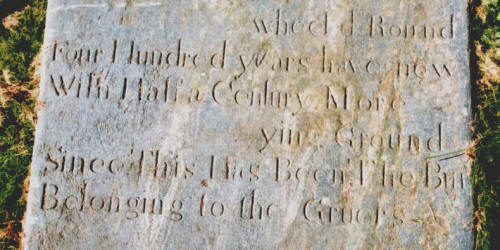
The grave of James Gruer of Tominrau, who died in 1807
A series
of so called ‘definitive clan texts’, state that the name Grewar is derived
from MacGrudaire or ‘Son of the Brewer’ and in this they share a
history with other names so derived, such as MacGruer, MacGruther and
MacCrowther. Although this is a credible origin of the name, the
name MacGruer which hails from around Boleskine in Invernesshire is a Bun
Sloinne or Sept name and does not appear to originate in this way. A
tradition exists amongst the Braemar Gruers that the name means either
‘greyhound’ or ‘fleet of foot’ as the Gruers were great runners.
The
children of the Clan Gruer are taught from an early age to this day that
during the reign of perhaps our greatest King, King Malcolm Canmore that he
wished to find the fittest of his subjects. To do this the king held a
great games and a race to the top of Craig Conneach, a hill
overlooking Braemar. This was the first ever Braemar Gathering. The prize
was a splendid baldric and sword. All the contestants were on the starting
line and ready to run and King Malcolm gave the signal to start by hitting
his shield with his sword. After they started to run, a late entrant,
asked the King to be permitted to run. The King considering the poor soul
did not have much of a chance, granted this request. To the amazement of
the other spectators, the youth took off with impressive speed and before
long was making considerable ground on the other competitors. Before long
he overtook his middle brother and caught up on eldest brother. After a
grueling run, the youth eventually won the race and due to his speed, was
nicknamed the Greyhound or Goather or Gruer in the Gaelic dialect of the
time. One tradition states that the Gruers of Braemar are said to descend
from the champion of Craig Conneach.
Another
oral tradition handed down to us from the Gruers of Tominrau family who held
lands in Braemar until the 19th century informs us that the
Gruers held the lands of Cluny near Ballochbuie to the east of Braemar since
ancient times, and lost when the Farquharsons took them by force, probably
at the end of 15th Century.
During the
period following the 16th Century, Mar was not owned in the
feudal sense and was held by the Crown as a Royal hunting forest. No-one
owned the land but rather each of the primary occupiers were Royal tenants.
The distance of Mar from the Crown centers of the south and the warring
nature of the Clans, meant that the extent of each Royal tenants lands were
dictated by how well these were held by the Sword rather than by the feu
charter. No leases or feu charters existed and during this period, an
opportunity was given to Clans on the make, who managed to grow their
numbers and military strength. The Earls of Mar who were granted the lands
during the 16th century were absentee landowners from the
lowlands and were quite happy for a dominant local Chieftain wishing to keep
law and order for them, while increasing their own wealth. By the beginning
of the 16th century this balance of power beteeen the
Farquharsons and Gruers was to change out of all recognition and against the
Gruers. The Farquharsons, who descended from a humble basket weaver on the
Braes of Angus “Farquhar of the Wands”, married the heiress to the tenancy
of Invercauld and his son Finlay Mor was eventually to rise to great power.
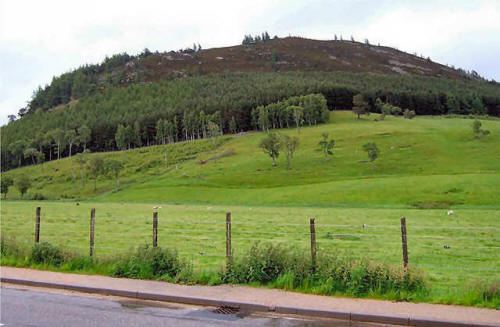
Craig
Conneach, in Braemar, Aberdeenshire, Scotland
His rise
was at the expense of the Gruers. For centuries, we enjoyed a powerful
position in the area, and according to Clan tradition, held the Castle of
Invercauld and the lands at Cluny, east of Braemar. During the 16th
Century. Clan Gruer tradition tells us that the Farquharsons took the
ancient Gruer lands by force and deposed the Gruers while feasting.
The list
of Royal tenants of 1539 survives and states that Finlay Mor, Farquhar’s son
was the occupier of Cluny and the Gruers did not receive a mention. Our
lands were lost and all records of our Chiefs were destroyed. The great or
Muckle Stane of Cluny, known by us as the Gruerstone or in the Gaelic
language, the Clach Nan Gruerach, was the ancient border or march
stone of the ancient clan lands of Cluny and has been to this day adopted as
the sacred gathering place of the Clan. Although once a proud and powerful
Clan within Mar and our clansfolk now dispersed across the world, to all
Grewers of name or blood our sacred stone remains as the hearth of our race.
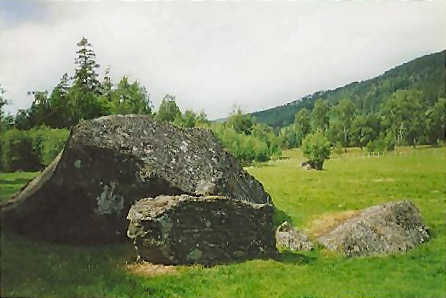
The Gruerstane or Muckle Stane o' Cluny
Following the loss of Cluny during the 15th century a bitter feud
erupted between the Gruers and Farquharsons. This ended in 1621 with a
marriage between Isobel Farquharson and John Gruer, our first recorded
Chief. Isobel, was the granddaughter of the elder brother of Finlay Mor,
the virtual founder of the Clan Farquharson. During the early part of the
17th century, the ownership of Mar changed, as the Great Earldom
of Mar, held by the Crown for centuries, was bestowed upon the Erskine
family.
The
Earls sought to give land grants to the existing royal tenants and important
officers of the area. The Farquharsons of Invercauld and John Gruer and his
wife Isobel Farquharson were one such family. They received a feu
charter
for the lands of Auchallater, in Glen Clunie to the south of Braemar in
1632. As such the Auchallater family became feudal vassals of the Earls of
Mar and bound in giving them military service in return for their lands.
The Gruer
Chiefs held their lands in relative peace and harmony for around a century,
until 1715 when the Earls of Mar, raised the Standard of King James VIII in
Braemar and as vassals of the Earl, Alexander Gruer and his eldest son and
heir Donald fought for the Earl. The Gruers were in attendance at the Earls
‘great hunting match’ intended to plan the rebellion. Later they fought
valiantly at Sheriffmuir and then returned to Auchallater on the defeat of
the Jacobite forces.
During the
period which followed, the Earls of Mar had their lands forfeited and
predominantly Catholic Mar was regarded as a rebel stronghold and as such
came under occupation by government troops. The Earls had their lands
forfeited by the Crown for leading the rebellion and this had such an effect
on the Gruers of Auchallater and the general population, that the Gruers did
not rise for Prince Charles Edward Stuart in 1745. During the years
immediately following the 1745 rebellion, the populace of the area was in
constant fear of being identified or accused of rebel activities, and
planning another rising. Many sought to show their loyalties to the Prince
by the wearing of tartan, a simple chequed cloth, considered so subversive
by the government of the time, that it was made illegal in 1746. A John
Gruer resident in Inverey outside Braemar, was one such subject who almost
fell foul of the act, when he was arrested and later released in 1755 for
wearing a tartan coat. The social and economic conditions of the area,
deteriorated after 1745 and a long trail of the inhabitants were said to
have taken the long walk down strathdee, behind a piper playing “lochaber no
more”, they were heading to coastal regions to sail to the new world of
Canada and Australia and many were to move south to the more fertile
lowlands for a better life.
During the
early part of the 18th Century, the Clan decided that the eldest
son should acquire Tominrau and the second son retain Auchallater.
Alexander, the second son of Donald Gruer of Auchallater, held onto these
lands until 1777 despite, his involvement in the Jacobite rebellion. During
this year, Alexander sought to raise finance for a dowry for his only
daughter May and spoke to his distant cousin, Farquharson of Invercauld to
raise the required sums. Invercauld agreed to the request but asked that he
use Auchallater as security, which Invercauld desired as it lay on the
borders of his own lands.
During
Alexander’s ride home he is said to have heard a cuckoo cry ‘Gowk you’ or
fool you and he later became ill. His brother, James Gruer of Tominrau,
whom had been granted the lands of Tominrau from his father some years
earlier, sought to help meet the re-payments, but he could not. The Gruers
lost Auchallater and the family died out in the male line in 1777.
The line
of Auchallater however continued in the Tominrau family with James Gruer of
Tominrau who had a large family. James son William inherited Tominrau and
the story of Clan Gruer comes full circle, in that William was one of the
three founding members of the Royal Braemar Highland Society which founded
the modern Highland games and William’s third son John Gruer, in 1859 won
first place in the hill race at the games and was presented with a splendid
ornamental dirk in a mahogany display case by Queen Victoria herself,
bearing the inscription 'Presented By Queen
Victoria To John Gruer. Braemar For Foot Race at Balmoral Castle, 22nd
September 1859.” In this, the Gruers continued
their tradition as great runners and being “fleet of foot” since the days of
King Malcolm Canmore.
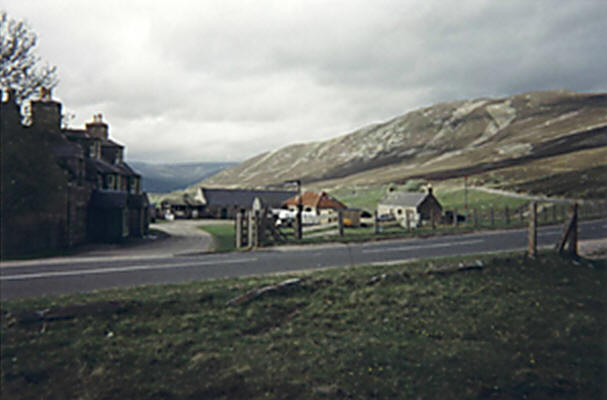
Auchallater in Glen Clunie, today
Tominrau
continued to pass down the Male line from William to James, and to James son
William who sold the lands and moved to the Orkney islands, in the far north
of Scotland. William’s eldest son Harold, later moved to India and became a
High Court Appeals Judge. Harold’s younger brother Edward, on returning
from Malaysia, where he had made his fortune, as owner of a rubber
plantation, acquired the estate of Erigmore near Birnham, Perthshire with
its impressive Victorian mansion house.
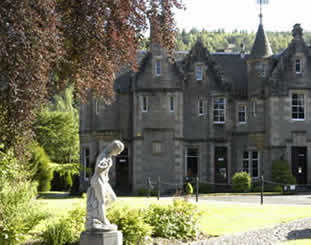
Erigmore House
Various
branches of the Clan existed in Aberdeenshire and Angus and from as early as
the 16th Century a branch of the Braemar family moved to Forter at the head
of Glenisla and acquired the lands of Dalvanie, by feu charter from Lord
Airlie. This cadet branch is immortalized in legend as great warriors and
when their cattle were stolen by a band of caterans, or highland reivers,
five of the Grewar brothers and their step father Mudie, a veteran soldier
in the Scots army and expert swordssman, awoke one day at their home of
Crandart at the head of Glenisla to find a band of Caterans or highland
reivers had stolen their entire heard of cattle. Mudie and the five young
Grewars set off in pursuit of the Caterans and headed to Caenlochan further
up Glen Isla in pursuit of the thieves. On reaching a shieling near Glas
Maol, Mudie asked that the young Grewars take their positions armed with
Claymores around the Shieling so that none could escape. Mudie confronted
the Caterans through the door and killed all but one. The last of the
Caterans punched a hole in the earth roof and escaped into the mist.
A year or
so later, three of the young Grewars were hunting in Caenlochan, when they
saw a band of Caterans approaching from the distance. The brothers agreed
to run in separate directions. One of the brothers proceeded to the Corrie
of Caenlochan and on turning round to view his pusuers, slipped on the ice
and fell to his death. The second ran over the summit and escaped via Glas
Maol. The third headed over the top of the corrie and while in close
pursuit jumped a wide stretch of the Allt eotch burn and escaped into the
mist with his life. The former place where the young Grewar died, is now
called Grewar’s gutter and the place where his brother jumped, Grewar’s
leap, the names are said to have been bestowed by the Caterans themselves.
During the
early part of the 17th Century, the Clan lost their lands at Dalvanie, and
remained there as tenants. By at least 1610 a member of this family, Finlo
Grewar acquired Wester Inverharity also at the northern reaches of Glenisla.
These lands were held for several hundred years, until the end of the 19th
Century. The name Grewar was relatively common in Glenisla from the 16th
Century until the 20th Century. Other branches who descend from the upper
Glenisla branch of the Clan include the Gruars of Eastercraig in Glenisla
and the Grewars of Lochbank, in Perthshire.
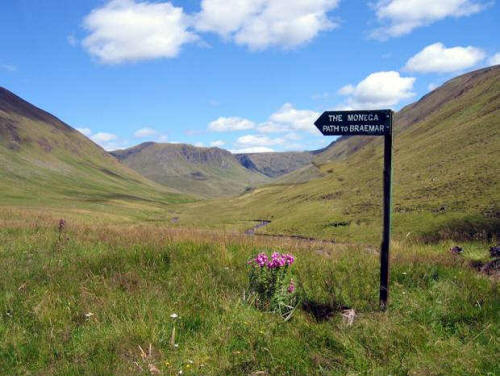
A view towards Caenlochan and Monega, at the head of Glenisla
The
Grewars of Dalnamer descend from the Dalvanie branch and became the Bards of
the Clan. Alexander Grewar was known as the Bard of Glenisla and continued
the highland oral bardic tradition. His brother James later acquired South
Persie in Strathearn and later in 1909 his family published his work “Lays
of the Grampians”, poems chiefly in the Scottish dialect. Another member of
this family David Steele Grewar, FSA scot was the author of “The Story of
Glenisla” (pub 1926), an important work on the history of the Glen.
Other
branches of the name exist elsewhere in Scotland. In Menteith and the
parish of Kilmadock some MacCruers, MacGrewars, MacGrewers changed their
names to Grewar and Cruer. Many of this branch moved south the Loch Katrine
area and further to Glasgow and Edinburgh from as early as the 16th
Century. The MacGruers owned the lands of Boleskine and Foyers, which they
took from the Grants by force during the 15th century. The MacGruers of
this area descend from or were followers of a Gruer Mor Fraser, and Gruer
Mor and his heirs were hereditary standard bearers to the Chiefs of the
Highland Clan Fraser. The MacGruers were almost annihilated during the
battle of Blar na Leine, where they fought bravely with their Fraser kinsman
against the MacDonalds and Camerons. Any connection between these branches
and the Gruers of Braemar and Glenisla, if any exists, was from a very early
and distant period, of which no written records now remain.
A member
of the clan from Glenisla, William Grewar moved to Edinburgh during the 18th
century and became Deputy Secretary to the Lord Robert Kerr, Lord Lyon, King
of Arms as Secretary to the Ancient and Most Noble Order of the Thistle.
During the twentieth Century, Melanie Gruer was Chief Spokesperson to the
Prime Minister of Canada and Doug Grewar was appointed Depute
Director-General of National Intelligence for South Africa. Geoff Grewar is
a Member of Parliament for Western Australia.
[Electric Scotland Note:
Got in a communication from
Lizelle Steenkamp:
I am a South African citizen
and a descendant of David McKenzie Grewar, who emigrated from Scotland to
South Africa In 1817.
Whilst reading the article, I noticed in the second last paragraph that you
refer to "Doug Grewar" who was appointed Deputy Director-General of National
Intelligence for South Africa. I would like to point out that the name
"Doug" is incorrect, as it was David George Grewar who served in that
capacity in South Africa during that time.
I trust that this correction will make a small contribution to your
excellent article, which I enjoyed very much.
Yours sincerely
DG Grewar
Following
the loss of many of its ancient clan lands and the dispersal of its
clansfolk to the four corners of the world, largely to England, Canada,
South Africa and Australia, the Clan is being largely rebuilt and still
maintains its traditions including clan ‘trysts’ at its ancient gathering
place at the Gruerstone, east of Braemar, and its members still maintain
their links with their Clan Country by patronising the Highland games of
Glenisla and Braemar annually. The Clan Grewar Society, which was
established in 2008 to support the Clan, now includes many hundreds of
members who are Grewers by both name and blood across the world. Despite
the Clan enjoying an ancient, colourful and noble history and being
recognized the world over, none of the Clan gentry sought to matriculate
armorial bearings since this requirement was imposed in 1672 until the
modern period. As such the Clan remains, as yet unrecognized by the Lord
Lyon King of Arms.
Note:
All photographs are copyright of Michael
Grewar 2008 |

